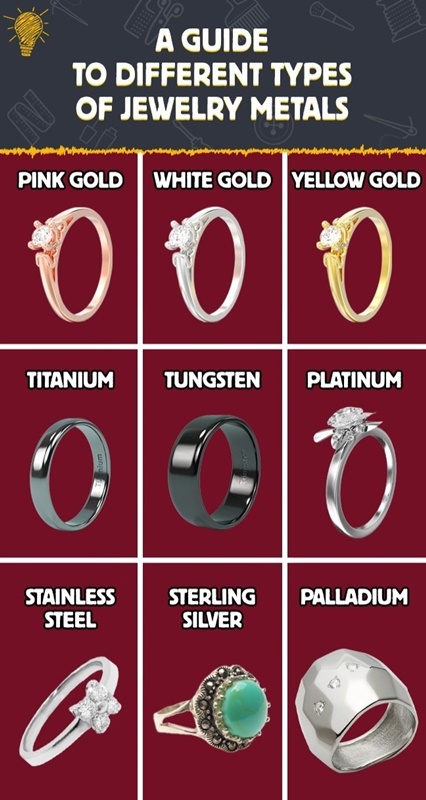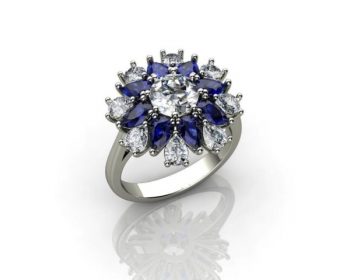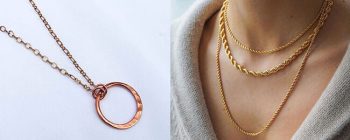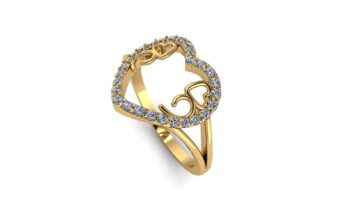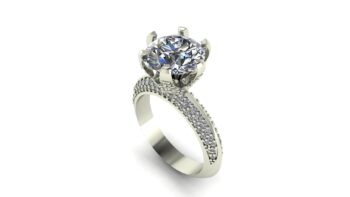Jewelry is made out of many different types of metal. Some are inexpensive, while some are very expensive. Then, you have some that are easy to work with and those can be difficult to work with. Some are durable and some aren’t. Yet, all have a time and place to be used. Many of the metals used today were first used thousands of years ago when metallurgy was developed. Others are relatively new metals that were unfathomable even 200 years ago. In this post, we will discuss the different types of metals that are used in jewelry. We will discuss their pros and cons, and other physical attributes.
Types Of Jewelry Metals – Silver
Silver, a lustrous and precious metal, has been valued for its beauty and versatility for centuries. Its brilliant white color and high reflectivity make it a popular choice for jewelry, coins, and decorative items. Silver is also an excellent conductor of electricity, making it essential in various industries such as electronics and photography. Additionally, silver jewelry is hypoallergenic, making it a great option for those with sensitive skin.
On the downside, silver jewelry is prone to tarnishing over time, requiring regular cleaning and maintenance to keep it looking its best. Some people may also be allergic to the alloys used in silver jewelry, leading to skin irritation. Additionally, silver jewelry may not be as durable as other metals, making it more prone to scratches and dents with everyday wear.
In conclusion, silver jewelry is a stylish and affordable option that can enhance any outfit. While it may require some extra care to maintain its appearance, its hypoallergenic properties make it a great choice for those with sensitive skin. Consider the pros and cons to decide if silver jewelry is the right choice for you.

Fine Silver
Fine silver, also known as pure silver, is a precious metal commonly used in jewelry making due to its brilliant luster and malleability. With a purity level of 99.9%, fine silver is softer than other metals. This makes it easier to shape into intricate designs. Jewelry crafted from fine silver is highly sought after for its elegant appearance and ability to complement a wide range of styles.
One of the advantages of using fine silver in jewelry is its hypoallergenic properties. This makes it a great choice for individuals with sensitive skin. Fine silver jewelry is less likely to cause skin irritation compared to other metals that may contain nickel or other allergens. Additionally, fine silver is known for its durability and resistance to tarnishing, ensuring that jewelry pieces retain their beauty and value over time.
In conclusion, fine silver continues to be a popular choice for jewelry designers and wearers alike. Its purity, versatility, and hypoallergenic qualities make it a top choice for creating exquisite pieces that stand the test of time. Whether it’s a delicate necklace, a statement ring, or a pair of elegant earrings, fine silver jewelry is sure to add a touch of sophistication to any ensemble.
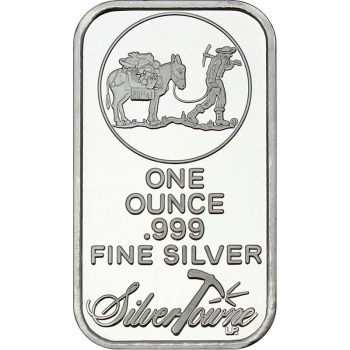
Sterling Silver
Sterling silver, a popular choice for jewelry, is an alloy made of 92.5% silver and 7.5% other metals, usually copper. This composition gives sterling silver the durability needed for everyday wear while maintaining its beautiful shine. It is often stamped with a “925” mark to indicate its purity. Jewelry made from sterling silver is versatile and can be found in various styles, from classic to modern designs.
One of the key benefits of sterling silver jewelry is its affordability compared to other precious metals like gold or platinum. This makes it a great option for those looking for high-quality jewelry without breaking the bank. Additionally, sterling silver is hypoallergenic, making it suitable for people with sensitive skin. With proper care, sterling silver jewelry can last a lifetime and even be passed down as heirlooms.
When caring for sterling silver jewelry, it is important to store it in a cool, dry place away from sunlight to prevent tarnishing. Regular cleaning with a soft cloth and special silver polish can help maintain its luster. Avoid exposing sterling silver to harsh chemicals or abrasive materials to prevent scratches and damage. By following these simple care tips, your sterling silver jewelry will continue to sparkle and dazzle for years to come.
Argentium Silver
Argentium Silver, a modern innovation in the world of jewelry, is gaining popularity among designers and consumers alike. Known for its bright, lustrous appearance and tarnish-resistant properties, Argentium Silver is a top choice for crafting high-quality jewelry pieces. Unlike traditional sterling silver, Argentium contains a higher purity level of silver, making it a durable and low-maintenance option for everyday wear.
One of the key advantages of Argentium Silver is its resistance to tarnishing. And we all know that tarnish is a common issue with traditional sterling silver jewelry. This unique feature allows jewelry made with Argentium Silver to maintain its brilliance and shine for longer periods. This reduces the need for frequent polishing. Additionally, Argentium Silver is hypoallergenic, making it a great choice for those with sensitive skin who may experience reactions to other metals.
Argentium Silver offers a modern and elegant alternative to traditional sterling silver for jewelry makers and enthusiasts. With its superior quality, durability, and resistance to tarnishing, Argentium Silver is a versatile option for creating stunning pieces that will stand the test of time. Whether you’re looking for a classic ring, a statement necklace, or a pair of elegant earrings, Argentium Silver is sure to elevate your jewelry collection.
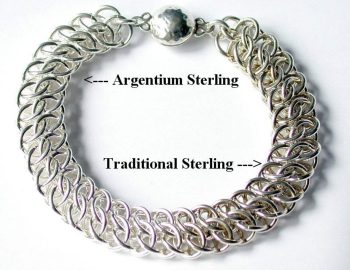
Types Of Jewelry Metals – Gold
Gold, a precious metal known for its lustrous beauty and rarity, has captivated humanity for centuries. Its shimmering hue and malleability make it a sought-after material for jewelry, coins, and decorative items. Beyond its aesthetic appeal, gold holds significant value as a symbol of wealth and prestige in many cultures worldwide.
Gold jewelry is a popular choice for many due to its timeless appeal and durability. The pros of gold jewelry include its resistance to tarnish and corrosion, making it a long-lasting investment. Additionally, gold jewelry retains its value over time and can be easily passed down as heirlooms. The luxurious and elegant appearance of gold jewelry also adds a touch of sophistication to any outfit.
On the other hand, there are some cons to consider when it comes to gold jewelry. One of the main drawbacks is the cost, as gold is a precious metal and can be expensive. Another con is that gold jewelry can be softer compared to other metals. This may lead to scratches or dents over time. Additionally, some people may have allergic reactions to certain alloys mixed with gold, causing skin irritation.
In conclusion, gold jewelry has its advantages and disadvantages. While it is a valuable and beautiful choice that can last a lifetime, the cost and potential for damage should be taken into consideration. Ultimately, the decision to invest in gold jewelry should be based on personal preferences and budget.
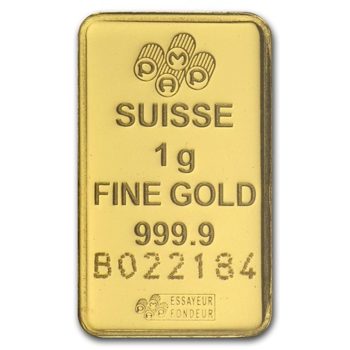
Yellow Gold
Yellow gold is one of the most popular Types Of Jewelry Metals due to its timeless appeal and durability. This precious metal is often mixed with other metals to increase its strength and create different shades of gold, such as white or rose gold. Yellow gold jewelry is versatile and can be found in various styles, from classic designs to modern and trendy pieces.
When purchasing yellow gold jewelry, it is important to consider the karat weight, which indicates the purity of the gold. Pure gold is 24 karats. However, it is too soft for everyday wear. So it is often alloyed with other metals. Common karat weights for yellow gold jewelry are 14k and 18k, with 18k being more pure and valuable. Yellow gold jewelry is a timeless investment that can be passed down through generations, making it a cherished and meaningful choice for any occasion.
Whether you prefer a simple yellow gold band or a statement necklace, yellow gold jewelry adds a touch of elegance and sophistication to any outfit. Its warm hue complements all skin tones and can be easily paired with other jewelry pieces. From engagement rings to bracelets and earrings, yellow gold continues to be a popular choice for those looking to add a touch of luxury to their collection.
White Gold
White gold, another of the more popular types of jewelry metals, is a popular choice in the world of jewelry. It is a stunning and versatile metal created by mixing pure gold with white metals such as nickel, palladium, or silver. This alloy is then plated with rhodium to enhance its shine and durability. This makes it a great option for those who prefer a silver-toned metal with the value of gold.
One of the main advantages of white gold is its ability to complement a wide range of gemstones. This allows for endless design possibilities in jewelry making. Its neutral color makes it a perfect setting for diamonds, sapphires, emeralds, and many other precious stones. White gold jewelry is known for its elegant and modern look, making it a popular choice for engagement rings, necklaces, bracelets, and earrings.
While white gold is a beautiful and luxurious metal, it is essential to note that its rhodium plating may wear off over time, requiring occasional re-plating to maintain its lustrous appearance. With proper care and maintenance, white gold jewelry can be a timeless and valuable addition to any collection, offering a sophisticated and chic aesthetic that never goes out of style.
Rose Gold
Rose gold, a popular choice for jewelry, is created by mixing pure gold with copper and silver. The copper content gives rose gold its warm pink hue. Conversely, the silver helps to tone down the redness of the copper. This combination results in a beautiful and romantic color that is versatile and flattering on all skin tones.
One of the advantages of rose gold jewelry is its durability. The copper content makes rose gold stronger than white or yellow gold, making it less prone to scratches and dents. Additionally, rose gold is a timeless choice that has been used in jewelry making for centuries, adding a touch of elegance and sophistication to any piece.
Whether used in wedding rings, necklaces, bracelets, or watches. Rose gold continues to be one of the popular Types Of Jewelry Metals for jewelry lovers around the world. Its unique color, durability, and timeless appeal make it a versatile option for both everyday wear and special occasions, adding a touch of luxury and romance to any outfit.
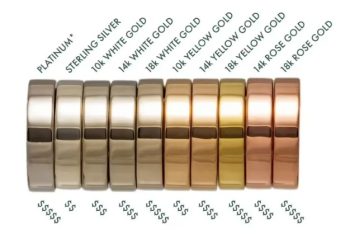
Types Of Jewelry Metals – Platinum
Platinum, a rare and lustrous metal, is highly sought after for its use in jewelry. Known for its durability and resistance to tarnishing, platinum is a popular choice for crafting exquisite pieces that stand the test of time. Its natural white color enhances the brilliance of diamonds and other gemstones, making it a favored metal for engagement rings and other fine jewelry.
In addition to its aesthetic appeal, platinum is also valued for its purity. Unlike other metals, platinum is typically 95% pure when used in jewelry, making it hypoallergenic and ideal for those with sensitive skin. Its density and weight provide a luxurious feel to jewelry pieces, adding to their overall quality and desirability.
While platinum jewelry may come at a higher price point compared to other metals, its timeless beauty and enduring value make it a worthwhile investment. Whether it’s a classic platinum wedding band or a modern platinum necklace, choosing this precious metal ensures a piece of jewelry that will be cherished for generations to come.
Types Of Jewelry Metals – Palladium
Palladium, a lustrous silver-white metal, has gained popularity in the jewelry industry due to its durability and hypoallergenic properties. Unlike other metals, palladium is resistant to tarnishing and corrosion, making it an excellent choice for everyday wear. Its natural white color also closely resembles platinum, offering a more affordable alternative for those seeking a similar look.
In addition to its aesthetic appeal, palladium is a lightweight metal, making it comfortable to wear for long periods. Jewelers often use palladium in combination with other metals to create durable and intricate designs. Due to its strength and malleability, palladium can be crafted into intricate patterns and delicate settings, perfect for showcasing gemstones and diamonds.
Moreover, palladium’s hypoallergenic nature makes it an ideal choice for individuals with sensitive skin. It is a safe option for those prone to skin reactions from other metals like nickel. With its increasing popularity in the jewelry market, palladium offers a versatile and stylish option for those looking for high-quality, durable pieces that stand the test of time.
Types Of Jewelry Metals – The “Contemporary” Metals
Mass Jewelry manufacturers often turn to a variety of so called “contemporary metals” of metals to create affordable pieces in modern designs. Among the popular choices are stainless steel, titanium, and tungsten. These metals offer durability and resistance to tarnishing, making them ideal for everyday wear. Additionally, their sleek and modern look appeals to those seeking a minimalist aesthetic.
Stainless steel is a versatile metal commonly used in contemporary jewelry due to its affordability and corrosion resistance. It is hypoallergenic, making it suitable for those with sensitive skin. Titanium, known for its strength and lightweight properties, is another favored metal in jewelry making. Its biocompatibility and resistance to scratching make it a top choice for both men’s and women’s jewelry.
Tungsten, a heavy and durable metal, has gained popularity in contemporary jewelry for its scratch-resistant properties. It has a lustrous finish that gives jewelry a sophisticated look. These contemporary metals offer a wide range of design possibilities for jewelry makers looking to create modern and stylish pieces that stand the test of time.
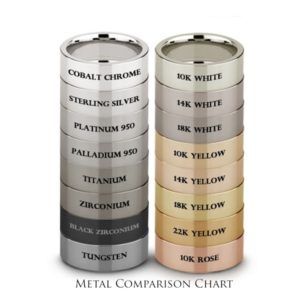
Cons
Contemporary metals offer a sleek and modern aesthetic, making them a popular choice for jewelry and accessories. Titanium, for example, is lightweight and durable, making it ideal for everyday wear. Stainless steel is another contemporary metal known for its strength and resistance to tarnishing. However, some people may be allergic to certain metals. So it’s important to consider any potential skin reactions before making a purchase.
On the downside, contemporary metals can be more difficult to resize or repair compared to traditional metals like gold or silver. Additionally, some people prefer the classic look of traditional metals over the modern feel of contemporary options. It’s also worth noting that certain contemporary metals may not hold their value as well as precious metals in the long run. Despite these drawbacks, the unique qualities and stylish appeal of contemporary metals continue to attract many consumers.
